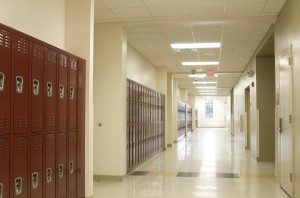
With kids back in school and safety increasingly on the minds of parents, schools face greater pressure than ever to maintain the security of their school facilities. Senior Commercial Security Consultant Richard Phillips has worked with schools throughout his career at Koorsen and well knows the particular challenge of maintaining selective access. Here’s what he has to say about keeping schools safe:
- “First and foremost, keep the school locked down.”
Maintain one central door for access, but have visitors buzz in or enter into a vestibule for clearance and registration. “You want to funnel everyone to one individual who can assess whether that visitor is supposed to be there,” Phillips said.
- “Utilize a thorough visitor management system.”
Traditionally, this has meant that a visitor logs in upon entering the building and is given a badge that clearly identifies him or her as a visitor and not a staff member (or unregistered guest). “That lets everyone know at a glance whether it’s okay for this person to be there,” Phillips said. “And it relies on a defined check-in/check-out procedure that includes ensuring this person has a viable reason to be in the school—that he or she is attached to a student.” The system falls apart, however, if there’s no method for checking that the visitor is legitimate; the school needs to maintain an approved list of visitors. - “Make sure that the entrances are not just closed off but monitored.”
Schools need to know when a door is opened, and they need to be able to see what’s happening when it happens. Is a student letting someone into the building? Leaving the building when he or she shouldn’t? Has someone propped open a door? “Having video surveillance tied to the doors enables the front office to pull up a camera whenever the door alert goes off and see right away who’s coming in or going out,” Phillips said. “They can make quick decisions about next steps.” - “Keep classroom doors locked.”
Although shooter situations are rare, they’re certainly front of mind in most communities. Any time there’s a violent intruder, limiting access as much as possible can buy a lot of time for the authorities to handle the situation. “Keeping the doors locked gives the first responders that extra time to get the situation under control.” - “Train the staff so that they know how to react to various situations, like a tornado, fire, or intruder.”
There’s no one-size-fits-all when it comes to keeping hundreds of people safe in emergency situations, and plans vary according to situation and facility, but the important thing is to have them in place and to practice. “Logic runs out the door when there’s a life-safety event,” Phillips said. “That’s why it’s so important to drill and train. You want the plan to become second nature.” - “Partner with law enforcement.”
Any advance information first responders have before they come to your building gives them a leg up when addressing an emergency. “Having a well-designed, well-laid-out fire system helps tremendously, as well,” Phillips said. “When your system makes sense, it’s much easier for the fire fighters to know where the problem is and get there quickly.” If you have mobile access to your video, you can share that with them while they’re en route, giving them a precise grasp of what they’ll find. - “Use access control instead of keys.”
Using an electronic access control system gives you much closer control over who gets in and out of the building—and when. It gives you a record of exactly who goes in and out, at what time, and through which entrance. It also enables a school to restrict access to certain days and times. - “Video surveillance can solve a lot of problems.”
Not just for intrusions or disasters but for day-to-day incidents, a video surveillance system offers a record of what happened within the school that can enable the best response. “It’s useful for forensic recreation and has gotten schools out of lawsuits when used in that way,” Phillips said. “There’s no ‘he said/she said.’ If there’s a fight, you see who threw the first punch and what led up to it.” - “Consider panic buttons in classrooms.”
Giving teachers a way to ask for assistance as soon as they need it can keep common situations under better control. If students are fighting, for instance, a panic button enables help to reach the classroom much more quickly and keeps the teacher from harm. “The intent is always to shut down an emergency situation as soon as possible,” Phillips said. “Which makes panic buttons a huge advantage.”
###
Koorsen Fire & Security was founded in 1946 and is a third-generation, family owned business. Over the years, Koorsen has become one of the largest and most respected fire and security companies in the United States with over 20 locations and nearly 700 associates. Koorsen Fire & Security is well-known for having the best training in the industry, and is insured and certified to design, install, program, service and repair virtually all fire and security products for any size business. Contact us to schedule your free on-site hazard analysis.

